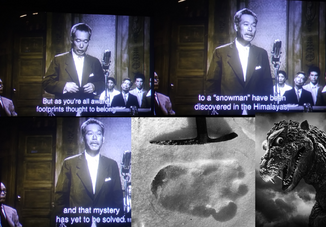
The famous Eric Shipton yeti footprint is mentioned in the original Godzilla (1954)
Godzilla" is a transliteration a combination of two Japanese words: gorira (ゴリラ?), meaning gorilla, and kujira (鯨 or クジラ), meaning whale. At one planning stage, the concept of "Gojira" was described as "a cross between a gorilla and a whale." The two words "whale" and "gorilla" describe Godzilla's traditional characteristics. The word whale represents his aquatic lifestyle and his bulky size. The word gorilla represents his sheer strength and the strategic thinking he uses when fighting against other monsters.
The Godzilla (ゴジラ Gojira?) franchise is a series of multi-media featuring the character Godzilla created and owned by Toho. It is recognized by Guinness World Records to be the longest continuously running movie franchise, having been in on-going production from 1954 to the present day (with several hiatuses). The film franchise consists of 28 films produced by Toho (three of which had American adaptations) and two Hollywood reboots. A reboot by Toho was released in 2016, while Legendary Pictures is proceeding with a planned trilogy of their own, with the second film being released at May 2019, the third film being released on March 2021, and there will be a fourth film that is scheduled to be released at April 2024.
Relation to Cryptozoology[]
Godzilla Creatures Based on Cryptozoology[]
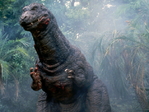
The Godzillasaurus
Throughout the Godzilla series, many of the antagonists, or the creatures Godzilla versus were actually inspired by creatures and concepts heavily influenced by cryptozoology. Some of these creatures include:
Godzilla
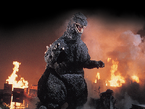
The Heisei Godzilla, an irradiated Godzillasaurus
Godzilla himself may have been inspired by living fossils, as in most incarnations, he is an irradiated prehistoric creature that has survived up to present times. An example would be the Godzillasaurus, a dinosaur that has survived long enough to live alongside humans. Godzilla (in the Heisei era) is an iradiated Godzillasaurus.
Anguirus[]
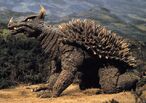
In the 1955 film Godzilla Raids Again, a creature known as Anguirus was introduced. Anguirus appeared only a year after Godzilla.
Anguirus (spelled "Angilas" in that film) was properly called an "angilosaurus," (which in Japanese is pronounced roughly the same as "ankylosaurus"), a dinosaur described as one of the stronger dinosaurs that lived in the prehistoric era. The idea to include this creature was also inspired by the crytozoological concept, living fossils.
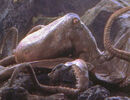
The Giant Octopus
Giant Octopus[]
In the 1962 King Kong vs. Godzilla, King Kong attacks a giant octopus (later named Oodako) based on the famous cryptid, the Kraken.
Aliens[]

The Hedorah is based on Atmospheric Beasts
Throughout the entire Godzilla series, Godzilla faces several extraterrestrials inspired by the cryptozoological concept of alien encounters during the 1950s-70s.
These creatures include King Ghidorah (a golden three-headed dragon and Godzilla's most-recurring foe), Hedorah (AKA the Smog Monster), Gigan (a cybernetic monster sometimes described as a "giant space chicken"), the 1970s Mechagodzilla (a robot version of Godzilla; only the original 1970s Mechagodzilla was an alien creation, the other three in the 1993, the 2000s, and 2017 were made by humans specifically to counter Godzilla), and many others. Hedorah, in particular, was based on the concept of Atmospheric Beasts.
Ebirah[]

The Ebirah
In The 1966 film Godzilla vs. the Sea Monster, the main antagonist, Ebirah, was inspired by the sightings of sea monsters. Specifically of giant crustacean cryptids.
Gorosaurus[]
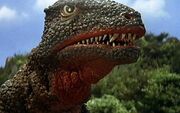
Gorosaurus
Gorosaurus (ゴロザウルス Gorozaurusu?) is a dinosaur that appeared in the 1968 Godzilla film Destroy All Monsters.
Gorosaurus is an allosaurid, an abrupt descendant of Allosaurus itself. The idea to include this creature was inspired by the crytozoological concept known as living fossils.
Tristar Godzilla series Creatures Based on Cryptozoology[]
In the cartoon series made for the Godzilla 1998 character, several cryptids like the Loch Ness Monster (Nessie) and other late surviving organisms are featured in their own respective episodes.
MonsterVerse Creatures Based on Cryptozoology[]
In the MonsterVerse Series, Earth is inhabited by "massive unidentified terrestrial organisms" (MUTOs), giant monsters of various shapes, sizes, and forms. Many of these creatures are notable to and have been heavily influenced by Cryptozoology. Some of these creatures include:
Mokèlé-mbèmbé[]
The Mokèlé-mbèmbé, which means "the one who stops the flow of rivers" in the Lingala language, is a dinosaur-like cryptid that lives in the Congo. It is said to look like a sauropod, or a long-necked dinosaur, such as Apatosaurus or Diplodocus. The Mokèlé-mbèmbé was the focus of the children's book Cryptid Hunters by Roland Smith. There have been many sightings in the Congo and Cameroon. Its meat is apparently poisonous, as a group of villagers once killed one and everybody who ate the meat died shortly after. Besides the Sasquatch, Loch Ness Monster, and Mothman, this is one of the most well-known cryptids.
In the movie Godzilla: King of the Monsters, there is a Titan located in Jebel Barkal, Sudan named after the Mokèlé-mbèmbé. in the novel, he is described as a grey quadruped with a pebbled reptilian back, with a head resembling an earless elephant, although his tusks point down instead of up. Each of his feet possesses five claws, and his front legs are slightly longer than his hind legs. The tail of Mokele-Mbembe is twice as long as the rest of his body. His mouth opens like a crocodile to reveal thousands of sharp teeth. He also has a curved horn on the top of his head, which glows with a faint green colour. he was re-awoken by monster zero's call, and began breaking out, he then used his trunk to grab several monarch scientists and ate them, before heading to Boston.
Bunyip[]
Aborigines used to tell tales of a creature that stalked the water and ate people. Many of the modern sightings that have come from Australian people come in a wide variety of descriptions.
The Bunyip, also known as the Kianpraty, is a creature of Aboriginal legend. It lives in swamps, billabongs, creeks, riverbeds and waterholes all over Australia. Bunyip in the Wemba-Wemba language means "devil" or "Evil spirit". The Bunyip is one of the main Australian cryptids; it was sighted as recently as the mid 19th century. Bunyip was featured as a kaiju in Godzilla: King of the Monsters, although only as a name on the map.
Amhuluk[]
Amhuluk is a dragon-like creature that is connected to drowning, sickness, and fog that comes from the waters surface. The First Nations group Kalapuya has found to Amhuluk to be living in a lake close to Forked Mountain. Originally Amhuluk desired to live on the Atfaliti Plains but moved due to his hobby: drowning everything he sees. Many things surrounding the lake is changed due to Amhuluk.
Amhuluk was also featured as a kaiju in Godzilla: King of the Monsters, although in name only.
Organizations and Methodology Similar to Cryptozoology[]
In the MonsterVerse Series, Earth is inhabited by "massive unidentified terrestrial organisms" (MUTOs), giant monsters of various shapes, sizes, and forms. Each of the films center around Monarch, a cryptozoological organization dedicated to studying the creatures, and their recurring encounters with the beasts.
The science of "crypto-zoology" that Monarch follows in their "alternate timeline" operates very similarly to that of the cryptozoology subculture of our world for a variety of reasons.
Emphasis on Sightings[]
First, Monarch (especially initially), relies heavily on sightings to identify organisms. Godzilla, for instance was first known from eyewitness accounts (sightings) of a "giant lizard that walked like a man" that seemed to be chasing Shinomura (a creature regenerated by Monarch) throughout the islands. Serizawa (a main Monarch scientist) called this creature "Gojira," after Pacific Island legends describing him. The practice of giving validity or consideration towards eyewitness accounts of unidentified creatures is also a major aspect of the cryptozoological subculture of our world. The linking of sightings to creatures of legend that match the description of the sightings are also prevalent practices of Cryptozoology. Sightings of unidentified creatures typically do not have much significance outside of Cryptozoology and corresponding subcultures.
Linking Legends with Potential Organisms[]
Monarch and their corresponding science depend on analyzing legends to learn about (or in some cases, predict) unidentified creatures. These analyzations of legends provide invaluable information for Monarch's study of their hidden creatures (MUTOs), as they are vital to the understanding process to learn about Kaiju. In the cryptozoology of our world, legends are also frequently used to understand the unidentified creatures sighted today.
